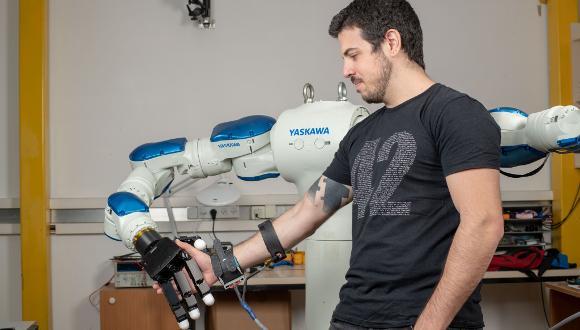Dr. Avishai Sintov has created a wearable device that can detect the movements of the forearm muscles and communicate the intentions of human activities which a robot will sense and reciprocate.

Select all
Engineering
Social Sciences
Psychology
Medicine
Life Sciences
General
Select all
Research
Prize
Innovations
In Focus
Events
Party
Conference
Ceremony
Event
Focus
Nomination

Research
Dr. Avishai Sintov has created a wearable device that can detect the movements of the forearm muscles and communicate the intentions of human activities which a robot will sense and reciprocate.

Human- robot collaboration requires intuitive understanding of human movements. Since our early childhood development, we learn that the different kinds of movements we perform in a certain way, will generate a certain response, more often than not, without any verbal communication. For example, if you offer a cup of coffee to your friend, they will intuitively reach their hand out to take the cup. In fact, by just looking at the cup in your hands, your friend will understand the intention and predict the trajectory of your movements, acting in response.
Publication
The research findings of Dr. Avishai Sintov and graduate student, Nadav Kahanovich, will be published in the The IEEE Robotics & Automation Letters.
Dr. Avishai Sintov is the Head of ROB-TAU lab lab at the Mechanical Engineering at Tel Aviv University. Dr. Sintov and his team of researchers study the prediction of human intentions in non-verbal communication, and aim to “teach” this to robots..
In their article, the researchers showed that a simple and inexpensive wearable device can detect different motions of human forearm muscles. The device contains 15 power sensors that stick to the skin and detect muscles contractions when a person takes various objects and moves a hand. Using their algorithms, the robot receives information about the objects in real time which imply about the intention of the person. The algorithms include a neural network that is trained to read and interpret the information from the device and accurately predict the intention of the interaction in real time.
The ability to predict the intentions of human activities helps the robot plan the movement for efficient and quick assistance. This approach will allow robots to work intuitively without verbal communication and cameras.

Photo: The robot identifies the objects and assists the person
Future Vision
In the future, this technology can assist people with disabilities, for example a wheelchair-mounted robot arm aid to assist with daily activities. It can be also applied in the factories and hospitals. Can you imagine a robot replacing a nurse and assisting a surgeon during medical procedures? We applaud our engineers and students for their fantastic discovery and research which will only enhance our world.
The research is funded by the Israeli Science Foundation.
Loving the problem is the greatest way to invent